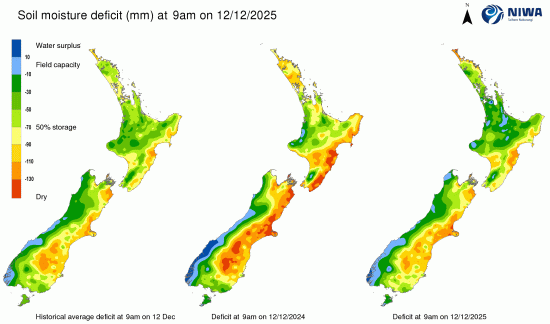Here's our summary of key economic events overnight that affect New Zealand, with news the US Senate has agreed the Trump budget, but only after the Vice President broke a deadlock with a casting vote. Financial markets are wondering about the wisdom in all this with equities hesitating, bond yields turning up, and the USD drifting lower. To be fair, none of these movements are large today. But the implications of massively higher US debt levels are as is the opening of the magic-money accounting they have adopted. It will be the bond market that makes the practical judgement.
First however, the overnight dairy auction came in as weak as the futures market suggested it might. The SMP price fell -1.7%, but only to match the prior week's Pulse event. However the more important WMP price fell -5.1% and back to levels last seen at the beginning of the year. One local reason may have been the sharp increase in volumes offered, +10,000 tonnes more than at the prior event two weeks ago, and +6.7% more than the event in the same week a year ago. This volume offer jump came as milk production rose in all key producing regions (except Australia).
Overall, prices were down -4.1% in USD terms at this event, down -5.2% in NZD as the greenback weakens further.
The price downshift will have analysts reaching for their pencils although it might be too soon for them to backtrack on their 2025/26 payout forecasts. Fonterra's current season results are pretty much locked in and will be reported in late September. But their new year may be off to a soft start.
Last week, the US Redbook index was +4.9% higher than year ago levels but still in the easing trend that started in early April.
The May level of US job openings rose unexpectedly to more than 7.7 mln largely on a surge for foodservice jobs. Analysts didn't see this coming but perhaps they should have given the sharp ICE immigration crackdowns underway. These roles at these volumes will be hard to fill.
The latest US factory PMI report from the ISM shows a sector still in contraction, being led by weak new order inflows. The internationally benchmarked S&P Global/Markit version reported an expansion and a moderate one at that. But both noted rising inflation pressures.
It appears that the expected rise in US June car sales didn't occur, dipping to its slowest pace of the year.
Apparently its a good time to be in the logistics sector in the US with inventory levels rising and supply chains being stressed. The Logistics Managers Index is running at an unusually high level.
The Dallas Fed regional services survey reported a continuing contraction, although not as steep in June as May.
And the RCM/TIPP Economic Optimism Index was expected to bounce back in July but in fact it resumed the decline in a trend that started in December 2024.
After falling to a recent low in April, Japanese consumer sentiment is on the rise again, back to where it was at the start of the year, but not yet back to 2024 levels. But at least it is rising.
Yesterday we noted that the official factory PMI for China "improved" but was still showing a contraction. Today, the alternative Caixin factory PMI came in a little better than that, rising from May's tiny contraction to June's small expansion. These shifts don't mean a lot, but at least they are going in an improved direction. The Caixin survey noted "Higher new order inflows supported a renewed rise in production. That said, the rate at which new orders expanded was only marginal amid subdued exports." Trump's trade war may have kneecapped Chinese growth but it hasn't knocked them over.
Overnight the ECB released the results of its May survey of consumer inflation expectations and they dipped to 2.8% when a small rise was expected. Consumers apparently thought inflation was running at 3.1% over the past 12 months. Separately the EU released its June CPI data and that shows it running at 2.0%, up from 1.9% in May.
In Australia, large parts of the east coast is hunkering down for a lashing of strong winds and heavy rain. And that will include Sydney.
The UST 10yr yield is now at 4.25%, and up +2 bps from yesterday at this time. The key 2-10 yield curve is less positive at +48 bps. Their 1-5 curve is now inverted by -15 bps. And their 3 mth-10yr curve has flattened completely so now no inversion again. The Australian 10 year bond yield starts today at 4.12% and down -4 bps from yesterday. The China 10 year bond rate is little-changed at 1.65%. The NZ Government 10 year bond rate starts today at 4.49%, down -6 bps.
Wall Street is marking time today with the S&P500 essentially unchanged. Its at a record high but seems to be having second thoughts about whether the situation justifies such lofty values. Overnight European markets ended mixed with Frankfurt down -1.0% while London rose +0.3%. Tokyo fell -1.2%. Hong Kong fell -0.9%, but Shanghai was up +0.4% in Tuesday trade. Singapore rose +0.6%. The ASX200 ended its Tuesday trade basically unchanged, while the NZX50 rose a full +1.0% and easily the best of the markets we follow.
The price of gold will start today at US$3,337/oz, and up +US$45 from yesterday.
American oil prices are marginally firmer from yesterday, up +50 USc at just on US$65.50/bbl while the international Brent price is up the same at just over US$67/bbl.
The Kiwi dollar is now just on 60.9 USc, unchanged from yesterday. Against the Aussie we are down -10 bps at 92.6 AUc. Against the euro we are down the same at 51.7 euro cents. That all means our TWI-5 starts today at 68.2 and unchanged from yesterday.
The bitcoin price starts today at US$106,292 and down -1.3% from this time yesterday. Volatility over the past 24 hours has stayed low at just over +/-0.9%.
Daily exchange rates
Select chart tabs
The easiest place to stay up with event risk is by following our Economic Calendar here ».
4 Comments
Population bomb goes the way of acid rain, runaway global warming, mad cow, peak oil, desertification, ice age, mass starvation... Is there anything the UN can do?
"...Every two years, the UN’s demographers revise their population projections, and for the past 10 years, they’ve always had to revise in the same direction: down. Next year, they’ll do so again. In reality, the worldwide population decline is set to begin decades ahead of their expectations.
...Japan, the canonical example of the threat that low fertility poses to a country’s economic prospects. At its peak in 1994, the Japanese economy made up 18 percent of world GDP, but eventually, the country’s demographics caught up with it. Now Japan’s median age is 50 years old, and the country’s GDP makes up just 4 percent of the global economy. Measured per hours worked, Japan’s economic growth has always been strong, but at some point, you just don’t have enough workers.
The fertility rates that doomed the Japanese economy ranged from 1.3 to 1.5. So imagine what’s in store for modern-day Colombia (1.06) and Chile (1.03).
The overly optimistic UN estimates have obscured just how urgent these questions really are. Because if the birth rate continues to drop around the world at its current pace, economic growth and workers’ retirement prospects will go the way of those projections: adjusting every few years to a smaller, sadder, poorer future."
https://www.theatlantic.com/ideas/archive/2025/06/birth-rate-population…
We are a grossly-overshot population.
And economic growth (really the extraction, consumption and ejection of planetary parts) was always going to be temporary.
Some people are born blinkered, some choose to remain that way, and some - who I have no time for - peddle propaganda to the latter echelon. When they could/should know better.
How are plans for the MAGA factories coming along? Anything reached the consenting office yet?
Would you invest millions in a factory when trade policy is completely up in the air and you could be undercut by some government offering the Trumps a new resort deal, or buying up one of their Cryptocurrencies? Corruption is bad for business.
It's OK, there is still some serious investment happening in the USA - the budget for ICE is going to increase from ~8 billion to ~30 billion, so the deportation industry is really going to heat up.



We welcome your comments below. If you are not already registered, please register to comment
Remember we welcome robust, respectful and insightful debate. We don't welcome abusive or defamatory comments and will de-register those repeatedly making such comments. Our current comment policy is here.